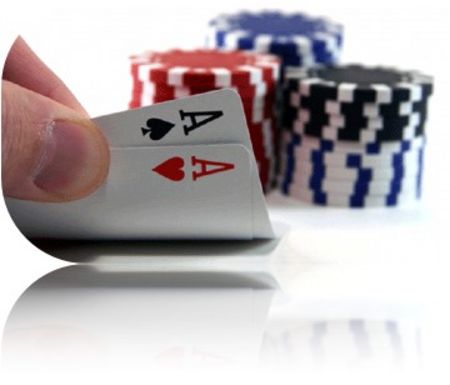Gut-shot Straight Draws

Gut-shot straight draws only have one card that can improve your hand; therefore,
you only have four outs rather than the eight outs of an open-ended draw. For
example, you hold T ♣ 8
♦ with a flop of A
♥ J
♦ 7 ♣ and need specifically a 9. With
only four outs, you are approximately 11 to 1 against improving your hand with one
card to come, so you need good pot odds to be able to draw. In addition, when you
are drawing on the flop you still need to discount your outs for the risk of losing on
the river to a full house, backdoor flush, or a higher straight.
Generally you are not getting sufficient pot odds to draw to gut-shot straights unless
the pot has been raised before the flop. The only exception is when there are a lot
of callers on the flop. For example, let's say there are five players who call preflop
in a $10-$20 game for a total pot of $50. If one player bets out and two players call,
you could probably call. Your pot odds are 8 to 1 and you can expect to earn
additional bets should you improve with so many players in the hand. However,
most games on the Internet require a raise preflop to justify calling since games are
usually not this loose.
Whenever you decide to draw to a gut-shot straight, you need to be sure that the
pot will not be raised behind you. Paying $10 to win a $110 pot is fine, but if the pot
is raised and you have to pay $20 to win $140, your pot odds are now only 7 to 1.
The best time to play gut-shot draws is when your call will close the betting.
Advanced Concept: When drawing to long-shot hands such as gut-shot draws, you should almost
always fold if there is a risk of someone raising behind you.
When the flop is two-suited, you should almost always fold, unless the pot is
exceptionally large. You may only have three outs rather than four, decreasing your
odds to 15 to 1. Even when you do improve on the turn, you still have the worry that
an opponent could hit a flush or better on the river.
Gut-shot draws using only one card in your hand are very weak draws. Sometimes
you will lose to higher straights, and there is also a decent chance you will have to
split the pot. In addition, it is very difficult to win more bets if you improve since your
opponents will not give you a lot of action with such a scary board. For example, 62
with a board of T87 is a very weak hand. A 9 would give you a straight, but you
would lose to an opponent holding a jack and would split with anyone holding a 6. If
you held J6, at least you would be drawing to a high straight (although you could
still lose to QJ), but it still is difficult to win many more bets with this type of board.
A lot of the value in playing gut-shot draws is the additional bets you hope to gain
on the turn and river. Since it is difficult to gain these bets when using only one card
in your hand, you should generally fold unless you have other outs to your hand
such as an overcard or a pair.
One exception to these guidelines about gut-shot draws is when the pot is
extremely large. If the pot is very large, you can sometimes justify calling two bets
on the flop, playing against a two-suited flop, or calling using only one card in your
hand. For example, with a pot of $200 in a $10-$20 game, you could call a raise for
$20 on the flop or play a gut-shot draw with three outs for $10.
Betting strategies for gut-shot draws are generally straightforward. You should
usually never bet out first or raise, unless you have a semi-bluffing opportunity or
other value to your hand. However, to try a semi-bluff, the probability that your
opponents will fold should be pretty high since you do not have very good odds to
improve your hand.
Like other draws, gut-shot draws increase in value when you have a pair or
overcards. For example, with a T86 flop, all of the following hands would have
additional outs: T9, A9, K9, T7, or QJ. You would have nine outs holding T9 if you
were confident that you were against an overpair. You now are only 4 to 1 against
improving instead of 11 to 1. An overcard can add three outs. For example, if you
are against KK and hold A9, you would have seven outs. As always, remember to
discount your outs for the possibility that they are counterfeited.
Two overcards and a gut-shot draw can also be a good drawing hand, especially if
you are drawing to the nut straight. For example, you hold QJ with a 987 flop.
However, a hand like KJ is much weaker since you may have to split the pot or
possibly even lose to QJ.
You have additional betting strategies when you add other outs to your gut-shot
draws. Top pair with a gut-shot draw is a strong hand, so you can usually bet out or
raise. When holding middle or bottom pair or an overcard with the gut-shot draw,
these are usually just calling situations unless you have a semi-bluffing opportunity.
NEXT...Review

